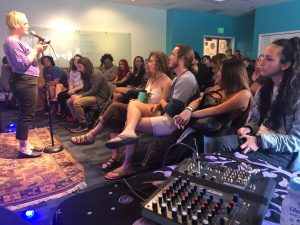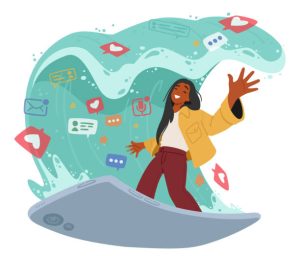For my Inspiration Report I chose to pursue the Power Of Stories path, and developed a plan for instituting a weekly storytelling workshop and open-mic and my local library. Storytelling is so essential to what makes us human––so I was distraught to have to wade through a sea of papers about corporate storytelling and branding to sift out the research on how storytelling at a community level builds valuable connections and develops empathy––but I managed! The finished report was designed in Canva.
Infinite Learning Reflection Blogging: Professional Learning Experiences
While its not something I’ve spent much time considering, I realized during the PLE module that I’ve somewhat relegated PLEs to being a thing of the past. I remember my parents traveling occasionally for conferences related to their work when I was young, but in every company I’ve worked for, there’s always been a sense of not having funds for that. I’ve only ever been offered DEI and various sensitivity trainings, which are great, but also seem to function on more of a liability level for the company than professional development for the likes of me.
Which is why two things really struck me during this model: that in the digital age, there are countless smaller and ongoing ways to pursue professional development, and that it won’t hurt to ask for more. I really adored the 23 things format and can see why its held such lasting success. Small chunks of relevant information is both immediately applicable to the workplace and not intimidating to undertake for the already busy professional.
According to The Strategic, Curious, & Skeptical Learner, I suppose I’d consider myself a Curious Ad-hoc Learner: passionate and excited to learn relevant information, but with the understanding that the doing of such is entirely up to me. I’d jump on any 23 things set that was pertinent to what I’m working on at any given time. I suppose I’ve assumed that Strategic Learners are also a thing of bygone eras, which is why I was so struck by this quote in the piece:
So I just started asking for stuff. I’d say: can I go to this, could I do this, I need to do a photography course because I’m the social media person. I need to go to this conference, . . . so yeah, so I just started asking and I actually got to do quite a lot of professional development in that space, because I asked for it.
I wasn’t aware that was something a person could do. It comes up later on in the Skeptical Learner section, quoting people who feel that people who go to conferences are part of some elite in-group where those opportunities still exist. There are a few staff members at the bookstore I work at that still go to conferences a few times a year. The process of attending has never been offered to me. Perhaps they simply asked. And perhaps I should, too.
Power Of Stories Reflection Blogging
There have been modules where I encounter new and exciting ideas, and modules where ideas are reinforced that I already know deeply to be true. That stories are powerful tools of establishing identity, community, and creative spaces is the later.
I spent my early twenties devouring storytelling podcasts. I started with The Moth, which is one of the better known, and then went down endless rabbit holes of different storytelling organizations–I’m fairly sure that RISK!, the podcast where “people tell true stories they never thought they’d dare to share” is my most listened-to podcast of all time, and that’s a high order! I listened to these stories constantly: while making breakfast, commuting, at work when I could, at the gym, everywhere. In retrospect, I’m so grateful that I was able to seek out and find such a diverse set of stories at such a young age, because it has set me up well to move through life curious and with an open-mind, while also understanding the comforting truth that there is no conundrum I can find myself in that has not been faced and survived by many people before me.
The next natural step for me was to step up to MC a weekly poetry open mic, which I did for four years up until the pandemic hit. That was where I got to see the incredibly powerful way telling a personal story honestly can build a strong community like nothing else–hearing all of those stories had bolstered me as a person, but to see the direct connection formed by sharing them in person brought things to another level.

Picture of me sharing my story through poetry with my community back in 2019.
So it seems obvious and exciting that incorporating story telling activities into library programing is such an easy and good fit. All of the ideas that have been floating around this course of community, creativity, gathering, and learning all scaffold so well into storytelling events. The act of writing one’s story can be so empowering and healing, and the act of hearing others’ builds empathy and community.
Stories are what made us all fall in love with libraries in the first place. Community storytelling is a natural and wonderful project for the hyperlinked library!
New Horizons Reflection Blogging: Alexa and other AIs
Last fall I splurged on a new “smart” overhead light that can, besides lighting the room: switch between a full rainbow of colors, produce colorful, changing light patterns, and uses a built in AI to listen to the music I play and produce a light show that matches the rhythm and tone. Listening to music is one of my favorite ways to unwind, and I have had many moments this winter, lying on my bed and listening to music, reflecting on the artificial intelligence in my ceiling lamp. Sometimes it really nails the light performance, other times it feels out of sync either rhythmically or emotionally. The instinct to personify it is strong, especially when I feel that it really “gets” the music I’m playing.
I had similar thoughts reading the articles in the New Horizons unit reflecting on the ubiquity of Alexa and other AI-assistant devices in our homes. I’ve never lived with one, but will be moving in with my long-term partner this summer and expect their Alexa to make the move as well. I’m a little late to the game with AI-assistants, but I also feel ahead of the game with generative AI such as ChatGPT, and feel that the contemporary fear of AI is incommensurate with how easily we’ve welcomed it’s predecessor into our homes. The studies done on children who have always lived with Alexa are fascinating, as are any reflections on the human instinct to anthropomorphize the robots around us.
As with Alexa as with generative AI: the future is here and the best way to interact with it is to do so curiously. It’s easy to lend AI assistants and other technology the respect you’d offer a human assistant, but that seems to be an easy way to neglect exploring the real limitations and structure of the technology you’re working with. My partner and I really enjoy trying to confuse their Alexa, and push it up against the limits of its programming. Doing so reminds us of the (important to remember and easy to forget) fact that the little cylinder is really just a bunch of code that doesn’t understand reality as we do.
Just as libraries offer classes to teach basic technology skills to those later on the uptake, I think there are endless opportunities for classes to really explore AI. Many people alive today will live lives integrated with these technologies, and setting aside exploration space to think critically about them will be essential for healthy relations with these devices.
Innovation Strategy & Roadmap: Library Garden Project
I centered my Innovation Strategy & Roadmap project on the idea of creating a community garden at one of the branches of the Santa Cruz Public Library.
Community gardens seem to me to be natural extensions of the library. They are a safe, communal, free third-space that offers inspiration and resources, simply outside compared to the standard library’s walls. The food produced by these gardens can help fulfill the basic needs of the community, just as the library offers other essentials such as education, job training, wifi-hotspots, and other useful resources.
I read a lot of success stories in my preparations of libraries across the country developing community gardens, and wanted to reiterate my favorite quote here, although I also gave it a page in my presentation:
“A garden can be an expression of optimism: We plant seeds, hoping they will flourish; learn humility when things go wrong; and get comfortable with continual experimentation as part of an ongoing conversation with the land, community, and planet. In that sense, gardens are like libraries—and library gardens offer far more than attractive outdoor space.” ––Erica Freudenberger
My presentation and plan can be viewed here!
CYOA Reflection: Artificial Intelligence & ChatGPT
My social network has been staunchly divided into two camps: those that despise AI and consider it an affront to art and humanity, and those that are delighted by the new world on the horizon and all the services AI can offer.
I had never used ChatGPT until I enrolled in this MLIS program, and have found it to be an incredibly useful tool in early brainstorming processes. Using ChatGPT at the beginning of a project tends to let me start with a bigger picture rather than from a single point.
So, naturally, as libraries continue to adopt, share, and teach new technologies, an understanding of artificial intelligence will be essential in the field. Here’s where my pessimism comes in: I’ve watched many peers and members of my community make it to the present day without developing a strong ability to flag misleading content when they come across it on the internet. It’s a new arm of the literacy problem, but I continue to feel dismay when some obviously AI generated piece of media is taken at face-value by people I know. The timing feels rotten, as our country is really struggling to form a consensus reality at the moment, but I suppose that the only way is forward, and offering opportunities to educate library patrons is probably the most reliable difference we can make.
My favorite article in this collection was the article ChatGPT is Changing Information Architectures. Comparing the emergence of ChatGPT to the emergence of Wikipedia gives this novel technology a sense of historical precedence. It directly identifies what we’re experiencing as a common human reaction to new technology––fear––and reiterates that solution is curiosity and critical thinking.
Hyperlinked Communities Reflection Blogging
This is my fourth semester in SJSU’s MLIS program, and the most emphasized, highlighted, and returned-to theme across all of the classes I’ve taken so far is the need to innovate. The function of the library has changed, I have been told in lectures, readings, and assignments––we are no longer repositories of books, but purveyors of information and opportunities in the new world of digital literacy.
This seems self-evident and important, but much less clear is how to continue to innovate as technology continues to shift. There are many specific ideas (makerspaces! classes! open-floor design!) to this end that are excellent starting places, but seem to me to be somewhat tied to the current micro-era in the exponential curve of innovation.
What I enjoyed about this module is that it presented a mindset that will serve librarians well now, and continue to serve them as the future comes with whatever technology and developments that it may: that librarians should approach their work with a sense of compassion, curiosity, and openness to connection (Wholehearted Librarianship, in Professor Stephens’ words). A fundamental, but easy to forget, element to this is that technology is developed by humans, and reflects our innate drive to share, connect, and create. Centering these core instincts is a great place from which to navigate new technologies. A recurring theme in the readings this week was to connect with patrons, learn from them what they are hoping to achieve and what they want to explore, and then design library programming to serve that need in a feedback loop that centers connection and creativity.
This mindset will not become obsolete as many of the technologies we use today will, and gives the need to innovate a human-centered roadmap of the way forward.
Project X––Participatory Design & Information Literacy
If there is one theme that has been drilled into us repeatedly throughout the course of this MLIS program, it is this: the best way forward for libraries as an institution is to position themselves at the front of the wave of exponential change in information and technology we are experiencing as a species… and surf it.

The article that most caught my interest in our readings so far was Empowerment, Experimentation, Engagement: Embracing Partnership Models In Libraries––largely because it took the amorphous call to innovate and distilled it into not only clear examples, but included a framework to continue this distillation. Mathews, Metko, and Tomlin called this framework a partnership model, wherein the library strives to develop a relationship with their patrons that is grounded in dynamic, interdependent partnerships. They write:
“As this effort evolves, our attention moves beyond purchasing, licensing, and providing access to collections and encompasses a greater emphasis on content that students and faculty generate themselves. Libraries are repositioning themselves as laboratories for exploration, incubators for ideas, and essential collaborators across the teaching, learning, and research enterprises.”
Partnership models, as a phrase on its own, gets you deep into business lingo internet, but with after some searching, it became clear to me that what Mathews et al. describe as a partnership model is being spoken elsewhere in the information sciences community as participatory design. In simplest terms, participatory design is the process of involving the end-users of a design process in the process itself. For libraries, ask what do the patrons want? Then get them involved in making that happen. This cultivates “a co-creative environment of mutual learning, power sharing, and equity, with the objective of advancing together toward shared goals.” (Fargo & Young, 2023).
This seems to me that participatory design must be the ideal framework to implement a new era and understanding of the library’s function in society. As libraries are shifting from repositories of books to purveyors and navigators of information, developing a supportive place to explore, create, and strengthen information literacy skills should be central to their mission. Asking patrons what technologies they are curious about and what kind of making and learning they want to do is essential for direction in the sea of infinite possibilities we’re navigating, and also creates the strong community bond people want from their libraries.
In 2016, the Association for College and Research Libraries (ACRL) adopted a new “framework” for information literacy that better fits the ever-shifting information landscape we now live in. The six main concepts of their framework are:
- Authority Is Constructed And Contextual
- Information Creation As A Process
- Information Has Value
- Research As Inquiry
- Scholarship As Conversation
- Searching As Strategic Exploration
The library is in a uniquely ideal role to teach these concepts to the public, and because these are complicated ideas that need to be practiced to be understood, also provide ongoing programing that can strengthen and develop understanding of these essential skills. What I like so much about participatory design is that it seems to encompass *all* of the six information literacy frameworks––making it a great learning tool atop a great way to develop programs.
The first frame, Authority Is Constructed And Contextual, is at the core of participatory programing. By asking the patrons what they want to explore, moves aside the existing power dynamic that the library provides the programs you need, handing the authority of the design process to the community. The frames “Information Creation As A Process” and “Scholarship As Conversation” are so pertinent that you could use them simply to better describe the participatory design process.
In conclusion, the future of libraries is an exciting unknown, but why put the burden of determining what that unknown will be solely on the information professionals? By including the community and asking what they want to explore, a much richer and more relevant programming will evolve naturally.
References
Fargo, H., & Young, S. W. H. (2023). Participatory Design as an Approach for Library Assessment and Student Engagement. Journal of Radical Librarianship, 9, 11–47.
Framework for Information Literacy for Higher Education. American Library Association. (n.d.). https://www.ala.org/acrl/standards/ilframework
Mathews, B., Metko, S., & Tomlin, P. (2018, May 7). Empowerment, experimentation, engagement: Embracing partnership models in libraries. EDUCAUSE Review. https://er.educause.edu/articles/2018/5/empowerment-experimentation-engagement-embracing-partnership-models-in-libraries
Introduction
Hi everyone– my name is Zoe. This semester will be the halfway point in the program for me. I live down in Santa Cruz, CA. I’ve been working at the local book store, Bookshop Santa Cruz, for the last five years, which is where I’ve solidified my love of working with books and helping people find the literature they’re looking for. Hoping to enter the public library system upon completion of my degree.
Outside of the program, I tend to spend my time reading or kickboxing and occasionally getting involved with community theatre and other art projects. I enjoy live music, walks to the beach with my dog, and eating and making excellent food.
Here’s the dog that will be curled up next to me during all the readings and assignments:

Looking forward to the semester with you all 🙂